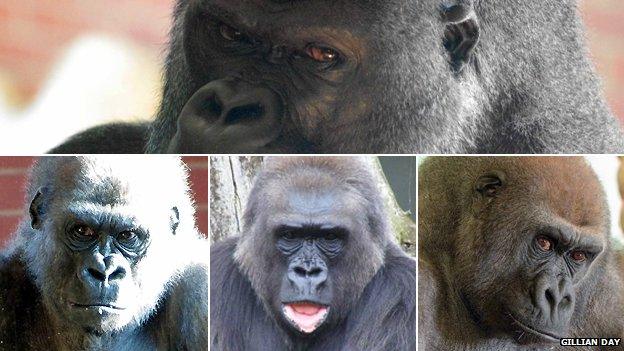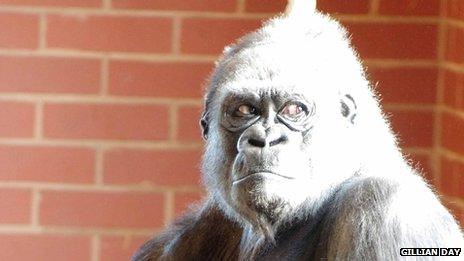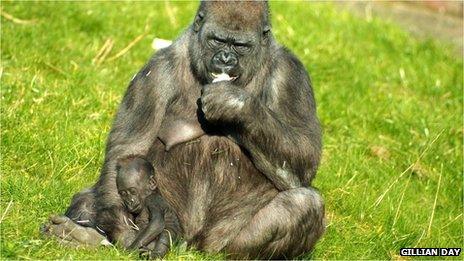How do you get gorillas to mate?
- Published

Oumbi (top) was brought to Twycross to mate with Orzala (left), Biddi (middle) and Asante (right)
"His role is to not let the females fight. He has to control the group and hopefully mate with them all."
In other words - according to zoologist Sharon Redrobe - getting gorillas to breed in captivity is challenging, not least for the chosen male.
In 2009, a silverback named Oumbi arrived at Twycross Zoo in Leicestershire.
The stakes were high. Populations of western lowland gorillas have declined by 60% in 20 years - making them critically endangered.
So how did the zoo know they had the right ape for the job?
Boy meets girls

Oumbi was chosen as a potential mate for three females - Ozala, Asante and Biddi.
Nothing had been left to chance. The European Association of Zoos and Aquaria (EAZA) selected the 20-year-old male with the help of its digital "stud book".
The database is designed to "match make" compatible gorillas, and rule out the possibility of inbreeding.
Zak Showell, a zoologist at Twycross, said: "Each individual [animal] has these complex and huge family trees which if you drew them out would be on fields of paper.
"If Oumbi was very related [to the zoo's female gorillas] it would be recommended to move him on."
First-hand knowledge of the apes is also essential.
"It's online dating, and it's blind dating to some extent," according to Sharon Redrobe, zoological director at Twycross.
"We know their personalities and we have a lot of expertise to say, 'that's such a quiet gorilla, I don't think he'll do well with that female'.
"It's normal for one silverback to be in charge of a group of females and his role is to stop them fighting.
"A good silverback should actually take charge and slap females down."
Even after a male gorilla has been carefully selected, there are still no guarantees.
The environment has to be just right, which means having structures for them to climb on to exhibit natural behaviour.
Their diet also has to be as faithful as possible. In the wild gorillas eat between 200 and 300 different plant species.
It worked for Oumbi and his chosen mate - Ozala.
In June 2012, staff at the zoo found out the 18-year-old was a month pregnant.
But how do you spot the signs so early in a 20-stone gorilla?
Maybe Baby

"We get them to pee on a stick" said Ms Redrobe. "They're so closely related to us we use the same pregnancy tests."
Coaxing a huge ape to do this would be difficult, so the keepers wait for the gorilla to urinate before collecting the liquid with a syringe.
Gestation takes a similar length of time to humans, giving zoo staff a rough idea when to expect the birth.
Also, like expectant humans, the shape of the bump changes and the breasts swell up as the date approaches.
"The mother is usually uncomfortable during that day," said Ms Redrobe. "She stretches, doesn't eat and doesn't lie down as much.
"Gorilla births are often in the early hours of the morning so we see this [behaviour] during the afternoon."
Oumbi and Ozala's baby - named Lope - was born on the morning of 3 January.
Six months on, Lope has started to leave his mother's side but he is being monitored closely, and so far he is fine and well.
Ozala had been knuckle walking with one hand while holding him in the other, but Oumbi's role was to simply keep out of the way.
The silverback will now take his turn to look after the youngster.
"He'll get more playful [with Lope] up until he's about five and that's when they'll be quite rough and tumble," said Ms Redrobe.
But it won't be fun and games forever. Oumbi will only tolerate his son for so long.
Learning the ropes

"Just like any adolescent Lope will probably start arguing with dad," said Mr Showell.
In the wild, male gorillas move off into their own territory when they become old enough, and this is replicated in captivity.
Ms Redrobe said it was a "judgement call" for how long the zoo waits before this happens.
"You don't want to wait for fights to break out," she said.
"[But] if you wait long enough for the young male to see baby rearing he will become a good father."
Lope will be about 15-years-old when he is ready to start a family of his own and able to leave Twycross.
But he will not go straight into an enclosure with a set of females - he has a few things to learn first.
"They need to learn etiquette, strange as it sounds," said Mr Showell.
"[Males] go to things like bachelor groups. Young gorillas will join an older one that will teach them how to be big male gorillas."
Again, judgement is required from the experts to protect the youngsters, as Sharon Redrobe explains.
"If a male is put in with strange adults in a bachelor group at too young an age he will get frightened and, or, beaten up.
"There is no set formula but years of experience and good animal teams at modern zoos [can only help]."
By the time Lope reaches sexual maturity, gorillas, as well as the other great apes - orang-utans, bonobos and chimpanzees - could be all but gone in the wild.
There are around 500 gorillas in captivity in the European zoo community.
But Ms Redrobe disagrees that the apes should be released back to their African homeland.
"The wild isn't a safe place," said the zoologist, who has seen how apes are hunted in the forests of Cameroon.
"It's a sticking plaster [solution] just to chuck some zoo animals out into the wild. At the moment, we need to work on keeping their wild cousins safe."
The breeding programme will continue until it is safe to release captive apes back into the wild, she added.
With this in mind there could be a very small chance that one day Lope will live in the land his ancestors once dominated.
- Published19 March 2013
- Published29 January 2013
- Published10 July 2012